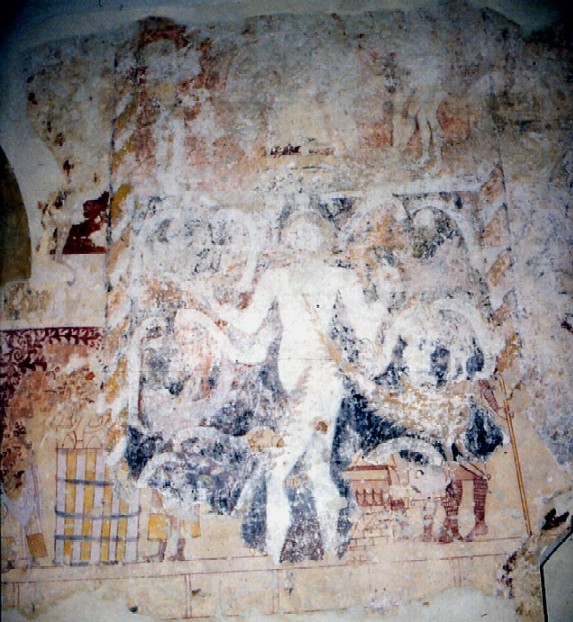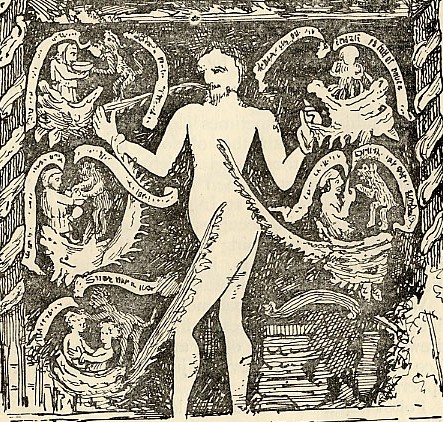Little Horwood, Buckinghamshire (†Oxford) c.1500
The Seven Deadly Sins

This painting is the top layer of several different subjects painted at intervals from the early 13th century on. The practice was widespread, with new painting, sometimes of the same subject, sometimes not, being superimposed on old. The Weighing of Souls at South Leigh, Oxfordshire, is an example on these pages.
The Seven Deadly Sins is at the centre, above some illusionistic painted brickwork. A standing naked male figure appears as a white silhouette from whose elegantly posed trunk and limbs project a number of scrolls, some with faint illegible lettering still visible. Each of these also has an explanatory visual detail of the sins in a form also found at Raunds and Hoxne.
The central figure represents the primary sin of Pride, with the other six arranged around it. At the top left is Gluttony, drinking from a bowl offered by a devil, and below this is Avarice, similarly receiving bags of money. At the bottom is Lust, with two people being encouraged in it by a third devil.

The pattern continues on the right where Envy at the top is unclear, although the words ‘is full of Envie’ on the scroll in Wall’s drawing can still be read. Perhaps significantly, the Hell-beast’s mouth holding the moralising picture is the only one to have visible, and vicious, teeth (Envy as a gnawing, devouring emotion is also glanced at at Hessett). Below is Wrath, a confrontation between a man with a dagger and a devil, probably urging him to use it on himself or someone else. Sloth, which must have followed below, has been obliterated by removal of the plaster from the underlying painting of St Nicholas. JC Wall’s drawing¹ below, made before 1925, shows much detail now invisible.
This 15th century painting represents the subject in its latest medieval development – a rigorous morality combined with considerable ‘realism’ in the handling of detail.
St Nicholas
Something can still be seen of the earliest subject, dating from about 1230 and showing episodes in the life of St Nicholas (4th century bishop of Myra), to whom the church is dedicated. At the bottom left is an object still recognisable as a barrel, with vertical staves in white and yellow and hoops in grey. The remains of two small figures within the barrel, holding out their hands in an attitude of prayer, can still be made out. Originally there would have been three figures, because this is the story, a medieval favourite, of St Nicholas’s miraculous rescue of three boys, who had been murdered by a butcher and pickled in a brine-tub to be sold to customers. Part of a figure in clerical vestments can be seen to the left of the barrel; this is probably Nicholas, and the legs and feet, in reddish hose, on the right of it may be those of the murderous butcher.
Several more pairs of legs, in horizontally striped hose, appear at the bottom right of the painting, standing to the right of part of a painted brick wall with a scalloped pattern at the top. One of the implied figures also holds a yellow staff or spear in his left hand and has a sword. He is probably a knight, the eventual husband of a character in another St Nicholas story, in which the saint’s prayers on behalf of three poor girls for dowries to enable them to marry and escape prostitution were answered by the miraculous provision of three bags of gold. All three girls married knights as a result, and St Nicholas is still the patron of children (his association with Christmas is well known) and young unmarried girls, among others. The Boys in the Barrel and another of his miracles, the Miracle of the Cup, are also now on the site, at Wissington in Suffolk. Other stories from his eventful life account for his patronage of pawnbrokers and sailors.
The leaflet in the church mentions a further painting of St Christopher forming an intermediate layer between the St Nicholas and the Seven Deadly Sins; that may be here, but I can see nothing of it now. There is though a very obscure painting to the right – above the niche which can just be glimpsed at the bottom right of the photograph – which could well be a 14th century St Christopher, and this is probably what is meant.
There is another very obscure painting above the Seven Deadly Sins – two pairs of legs at the right are still visible, but little else. It seems to be contemporary with the Deadly Sins, since the spiral pattern in the vertical border continues upwards on either side of it, and it may be some kind of adjunct to it. I suspect that it might have involved Adam and Eve, but that may be wishful thinking.
¹ Illustration in JC Wall, Medieval Wall Paintings, n.d., before 1925, Talbot & Co, London, p.197. (The note on copyright covering Wall’s drawing of St Thomas Becket at Hauxton also applies to this one)
† in page heading = Diocese